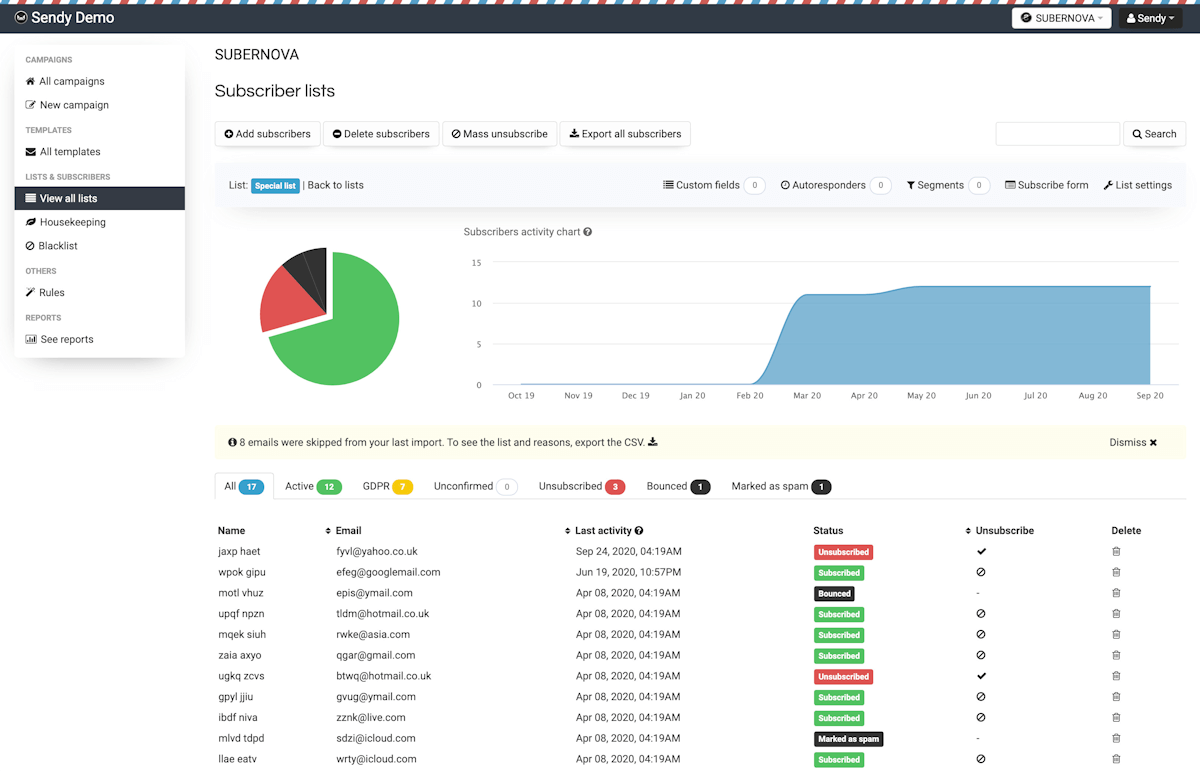What Is Sendy? (And How to Self-Host It)
Sendy is a self-hosted email newsletter application that works with Amazon SES for affordable email marketing. In this guide, you'll learn how to run it on shared hosting or a VPS.
Publish date: 4/5/2025
Sendy is a self-hosted email newsletter application that works with Amazon SES for affordable email marketing. In this guide, you'll learn how to run it on shared hosting or a VPS.
Publish date: 4/5/2025
Tired of skyrocketing costs on email marketing platforms? If so, Sendy could be your solution.
It’s an application you can host yourself, offering a stupid simple interface and lower costs by tapping into Amazon Simple Email Service (SES) to deliver your emails.

That said, in this guide, we'll explain what Sendy is, why you might want to self-host it, and how to easily set it up—whether you choose a shared hosting plan or a virtual private server (which can be surprisingly affordable nowadays). Let's dive in.
Sendy is an email marketing tool built in PHP, designed for self-hosting.
It connects to Amazon SES so you only pay for emails you send—rather than paying per subscriber. Many businesses like Sendy’s lower ongoing costs and the flexibility to host and manage everything themselves.
Self-hosting can save you money, especially if you have a growing contact list.
Some platforms charge based on the number of subscribers, whereas Sendy’s primary expense is tied to Amazon SES usage. So, if you only send out one email a week, or even one a month, you're only billed for that. And you can grow your email list endlessly without concern or having to keep upgrading your plan.
But beyond cost savings, hosting your own Sendy installation lets you maintain full control over your data, security, and compliance requirements. Which is quite important in its own right.
If you don’t need a huge amount of resources or want a simpler setup, shared hosting can be a quick start.
Here’s how:
.zip to your hosting account via FTP or your file manager.config.php file with your Amazon SES credentials and MySQL database details.Once complete, you can log into Sendy, create campaigns, and let Amazon SES handle your deliveries at a fraction of traditional email marketing costs.
For those who need more control or expect higher volumes, a VPS is an excellent (and scalable) choice.
xTom provides affordable high-quality NVMe-powered KVM VPS through our V.PS brand. Our Pro plan would work perfectly with Sendy.
Additionally, to make managing Sendy rather easy we'll use a well-known free and open-source web control panel named HestiaCP. This makes it so essentially anyone could host Sendy themselves (with little Linux knowledge required).
Here's how:
For example:
wget https://raw.githubusercontent.com/hestiacp/hestiacp/release/install/hst-install.sh
Then:
bash hst-install.sh
public_html folder.config.php with your Amazon SES credentials, database details, and domain settings.http://your-domain.com to complete Sendy’s installation steps. Once done, log in and start sending campaigns.By running Sendy on HestiaCP, you can easily manage multiple domains, email accounts, and server configurations without diving into command-line administration every time.
There you have it!
Sendy is a smart choice if you’re looking for affordable, self-managed email marketing.
Whether you prefer the simplicity of shared hosting or the control of a VPS, you’ll find both options viable.
At xTom, we offer many infrastructure solutions—including dedicated servers, colocation, IP transit, and more—to fit anyone's needs. However, for a simple Sendy setup, a KVM NVMe VPS from V.PS with HestiaCP can give you all the customization and power you need at an affordable price.
Thanks for reading and here's to self-hosted email marketing! :-)
Note: Still not sold on using Sendy? Give our 6 Best Self-Hosted Email Marketing Tools article a read.
Can I run Sendy without Amazon SES?
You can configure other SMTP services, but Sendy is primarily built to work seamlessly with Amazon SES. You’ll want to confirm that your chosen alternative is compatible with Sendy’s settings.
Will HestiaCP slow down my VPS?
HestiaCP is relatively lightweight and designed to manage your server without significantly impacting performance. It automates many tasks, making server administration easier without hogging resources.
What if my mailing list grows beyond my current hosting plan?
You can move from shared hosting to a VPS at any time. If your list becomes very large, consider dedicated servers or even colocation.
Does installing Sendy require advanced technical skills?
Basic familiarity with hosting, FTP, and setting up databases helps. If you’re comfortable handling a control panel, you can typically manage Sendy’s installation.